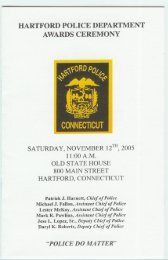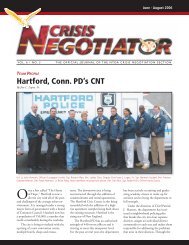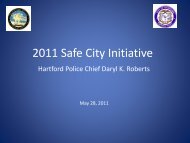Community Court Newsletter - Hartford Police Department
Community Court Newsletter - Hartford Police Department
Community Court Newsletter - Hartford Police Department
Create successful ePaper yourself
Turn your PDF publications into a flip-book with our unique Google optimized e-Paper software.
SEATTLE AND HARTFORD:<br />
A TALE OF TWO CITIES<br />
(AND THEIR COMMUNITY COURTS)<br />
By Kendy Rossi<br />
During a recent visit to her hometown of Seattle, Kendy Rossi took the time to visit the Seattle <strong>Community</strong><br />
<strong>Court</strong>. Kendy has worked as mediator and case manager for the <strong>Hartford</strong> Area Mediation Program since<br />
2005, and was recently promoted to Program Manager. She can be reached at krossi@cpa-ct.org. HAMP, a<br />
program of <strong>Community</strong> Partners in Action, is one of many partnerships in the <strong>Hartford</strong> <strong>Community</strong> <strong>Court</strong><br />
network of service providers. For more information, go to www.cpa-ct.org or<br />
www.jud.ct.gov/external/super/spsess.htm#<strong>Community</strong><strong>Court</strong> .<br />
As the Mediation Specialist for <strong>Hartford</strong> <strong>Community</strong> <strong>Court</strong>, I have witnessed the community court model in<br />
action for almost five years. Like other community courts, <strong>Hartford</strong> deals with misdemeanor offenses that are<br />
often minimized or dismissed if handled in higher-level courts. Although the unlawful acts are typically low-level<br />
and non-violent, they have a negative impact on other citizens, and on quality of life in the community as a<br />
whole.<br />
Research has shown that the problem-solving approach of community courts can “reduce crime, improve<br />
compliance with court orders, and enhance public confidence in justice.” 1 How do they do all this? What I have<br />
witnessed at <strong>Hartford</strong> <strong>Community</strong> <strong>Court</strong> is that the judge and staff employ a variety of creative sanctions and<br />
services, all of which reflect some basic principles: hold offenders accountable for their actions and expect them<br />
to participate in solutions; provide support where needed to address chronic problems; reach out to individuals<br />
and communities who are affected by the unlawful behavior; and create partnerships so that the social and<br />
judicial systems work together for the greater good. Makes sense, doesn’t it? When it works, the community<br />
court model is an innovative way to build the capacity of individuals and to restore faith in an overburdened<br />
court system. And <strong>Hartford</strong> <strong>Community</strong> <strong>Court</strong> has been<br />
making it work for over eleven years now – which is why it was<br />
selected as a Mentor <strong>Court</strong> in 2009 by the Center for <strong>Court</strong><br />
Innovation (CCI). Two other courts in the nation were given<br />
the same distinction: those located in Seattle, Washington<br />
and Dallas, Texas.<br />
Clearly I am a believer in this restorative model of justice; in<br />
many ways, it parallels the principles of the mediation<br />
profession in which I work. However, according to CCI:<br />
“<strong>Community</strong> courts are not designed to be cookie-cutter<br />
models; in a perfect world, each would be specifically tailored<br />
to reflect the needs of the neighborhood in which it is<br />
housed.” 2 And so, since I am a Seattle native, I decided to<br />
investigate the community court located in my hometown to<br />
see how two exemplary programs might compare.<br />
continued continued continued continued continued on on on on on next next next next next page page page<br />
page page<br />
Kendy Rossi in Seattle
















